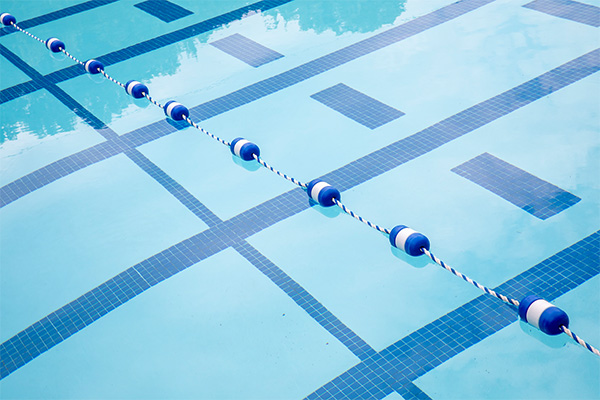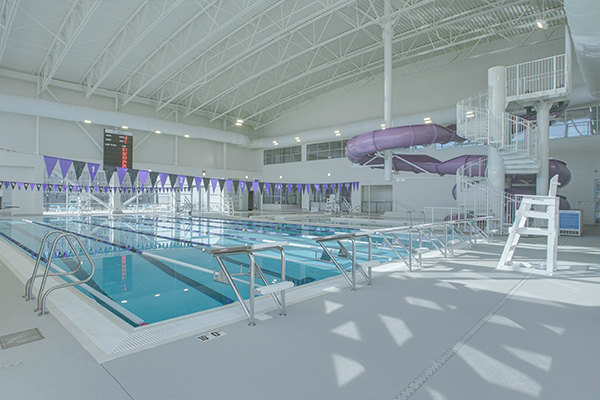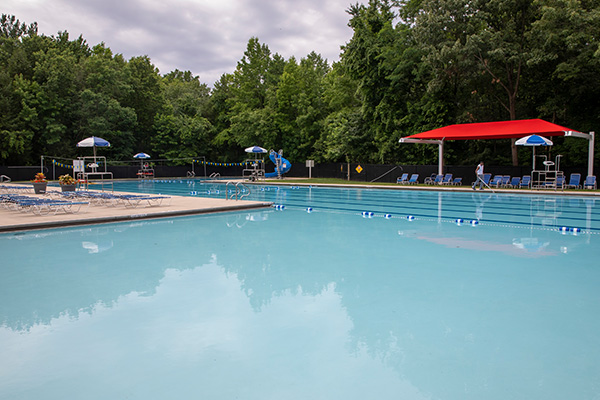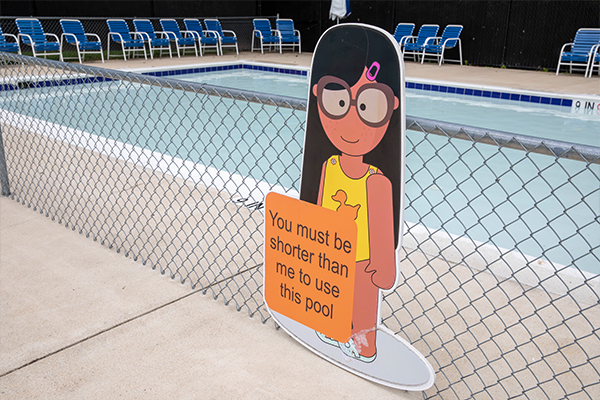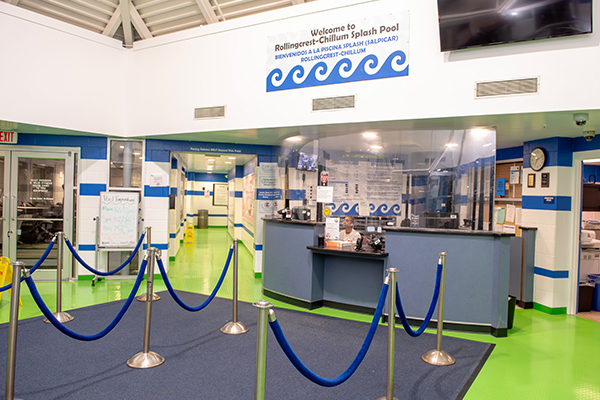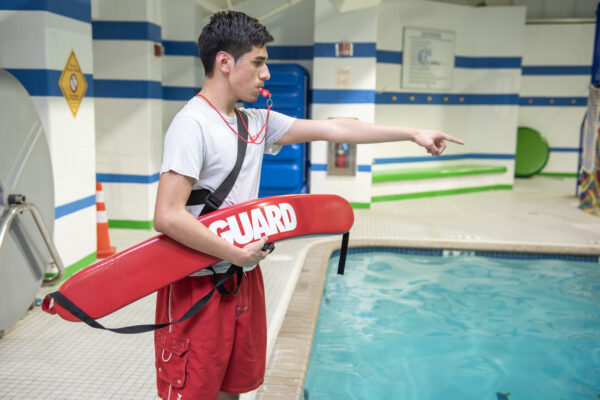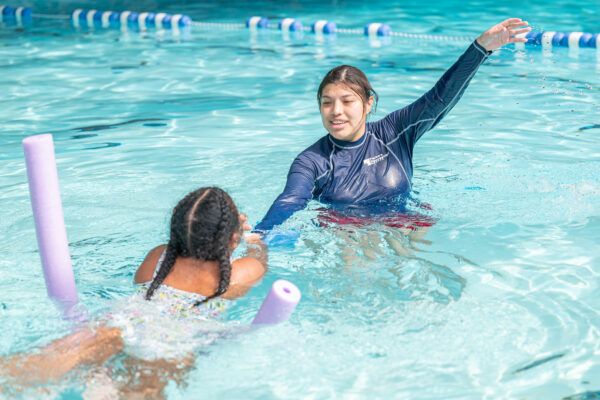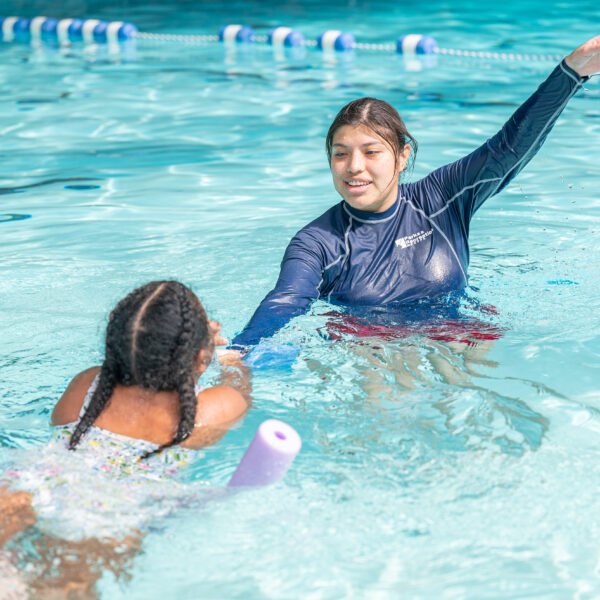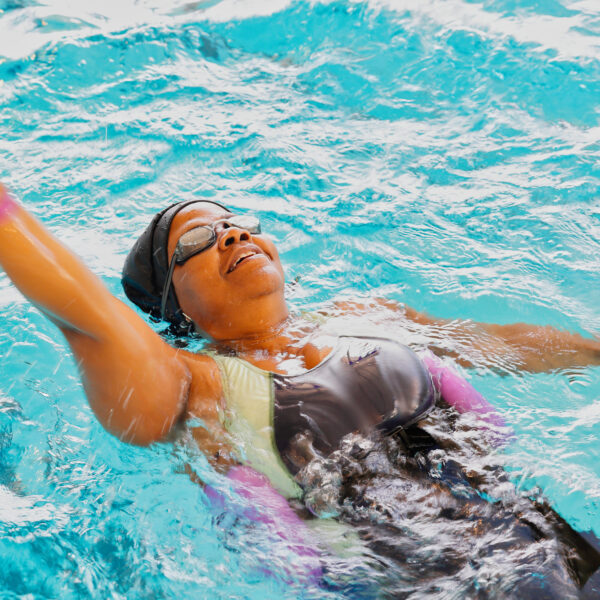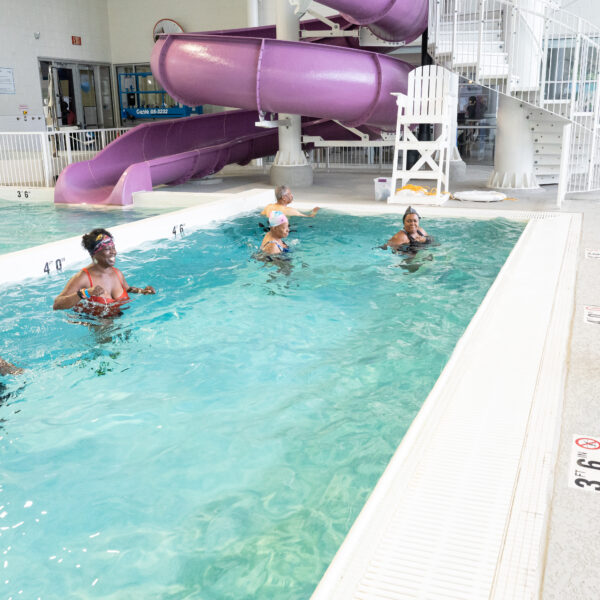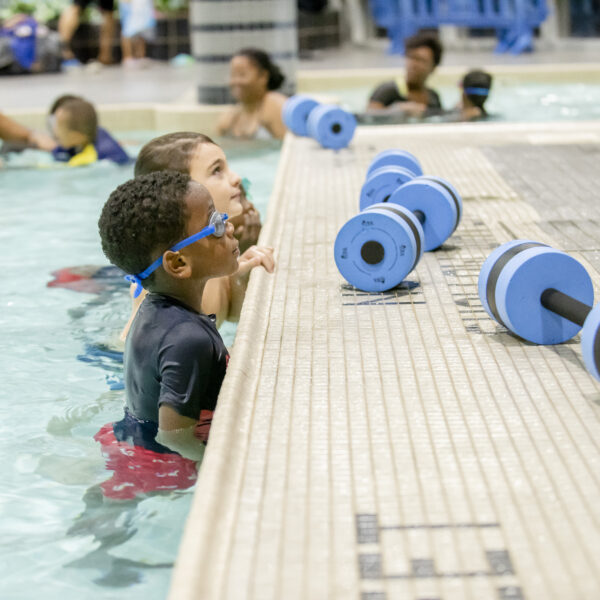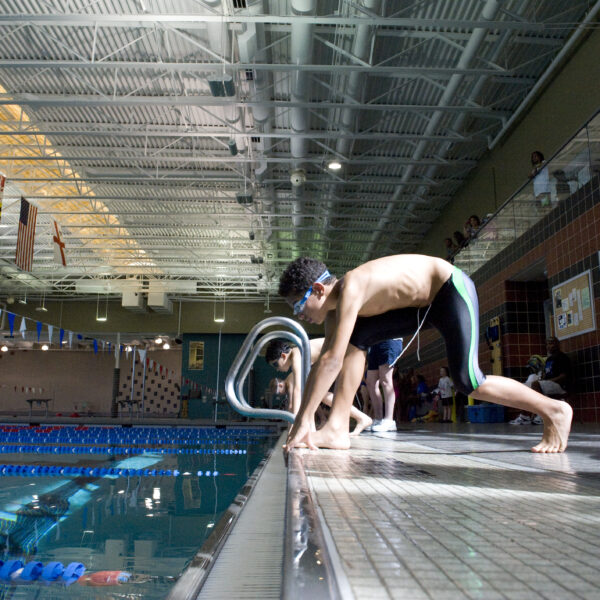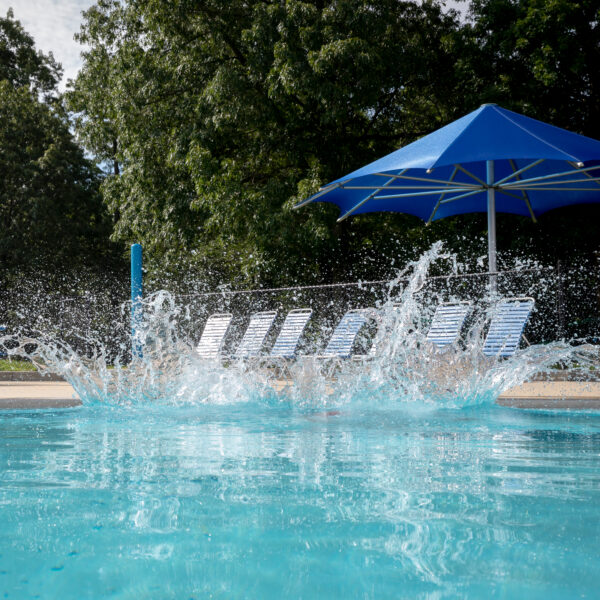Aquatics
Welcome! Click below to learn about our aquatics programs
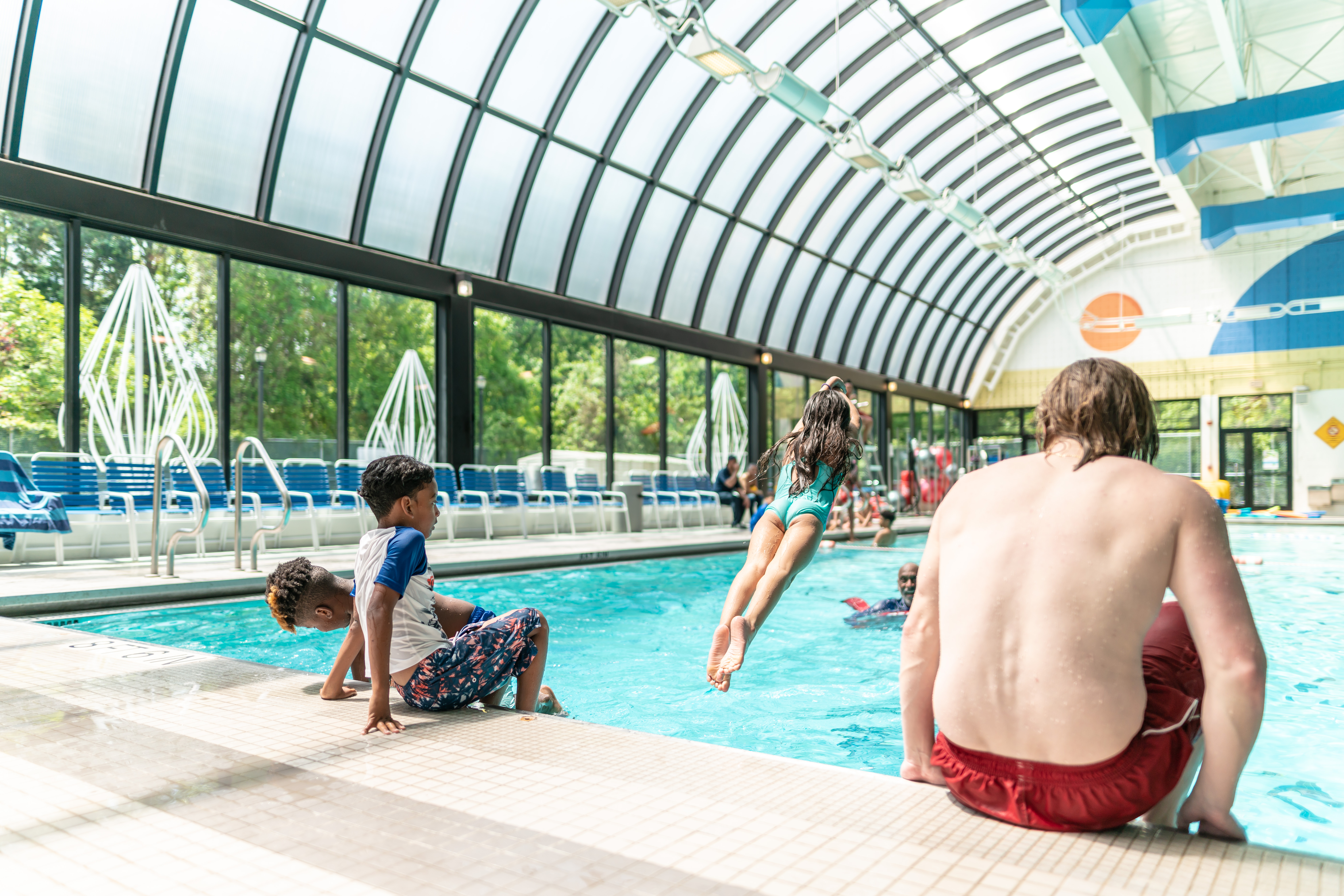
Take A Look At Our Pools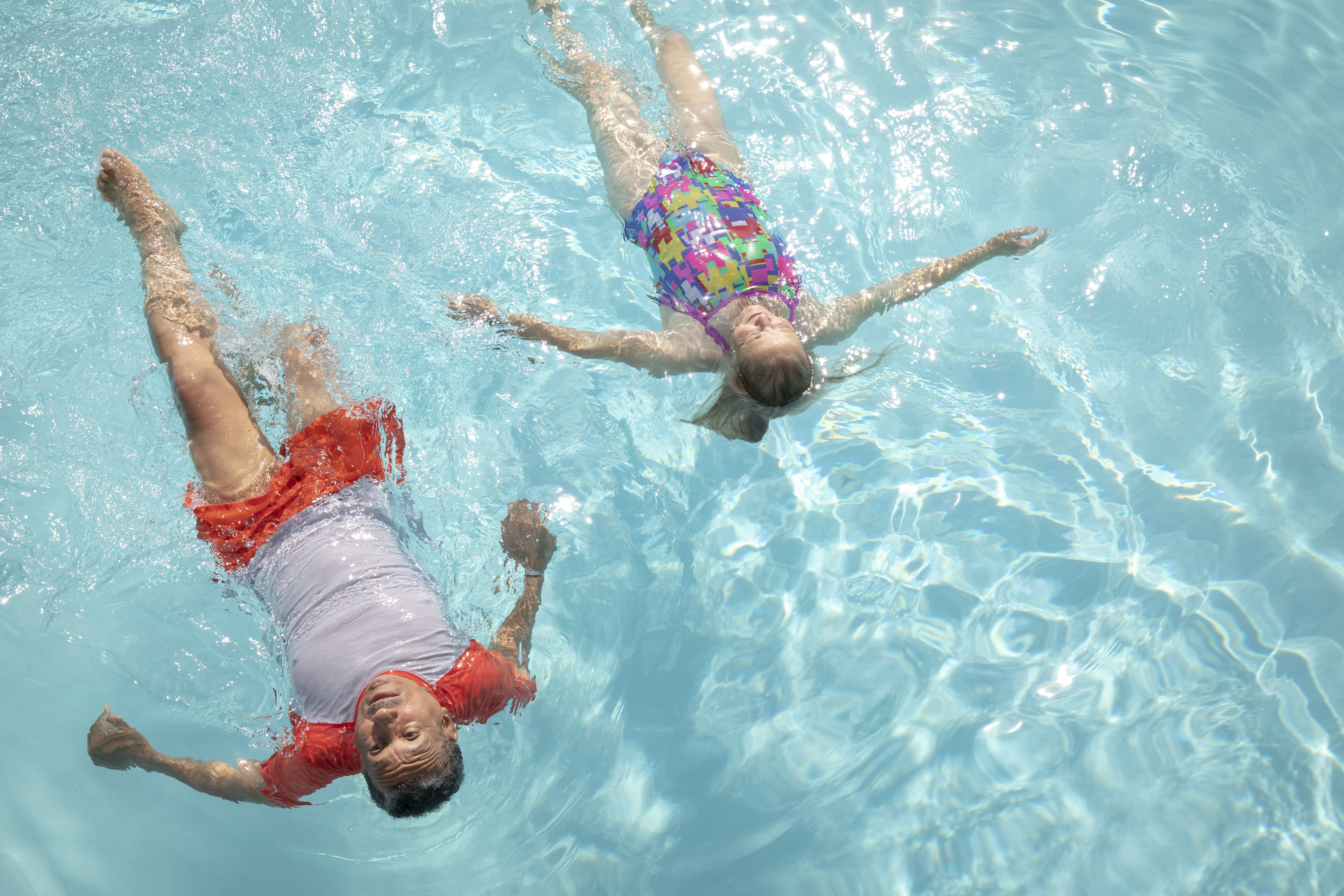
Class, Programs & Swim Team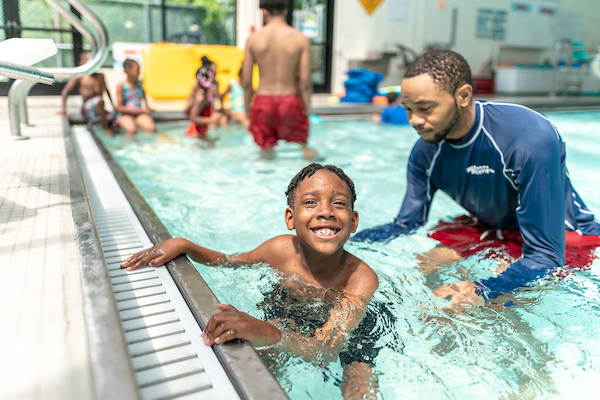
Learn About Water Safety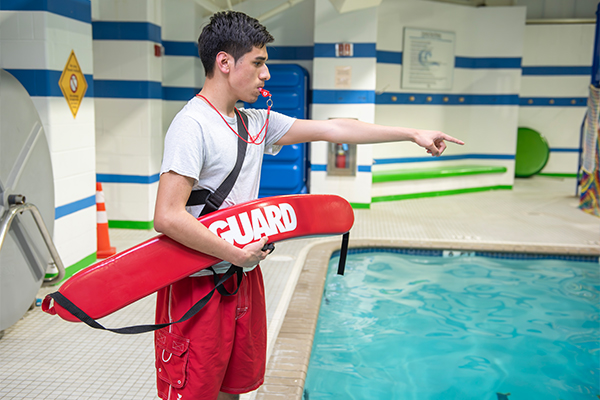
Start Your Training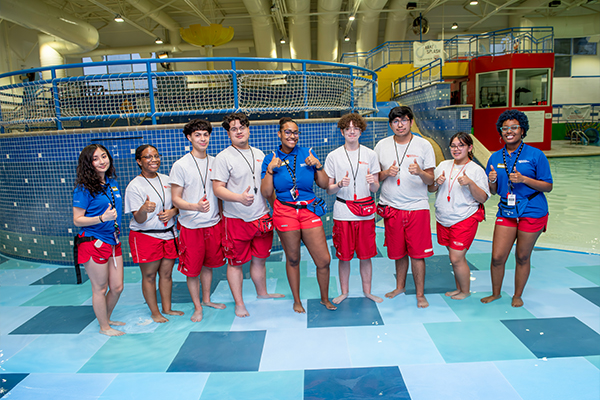
Find Employment
Rentals and Reservations
Individual Reservations
Patrons are encouraged to sign up to receive PGPARKS ALERTS/Nixle notifications for the latest updates on the status of pool operations, schedules, emergency closures, etc. To sign up for text and/or email notices, please visit PGParks Alerts.
The outdoor pools are very popular and tend to reach capacity early in the day/sessions on weekends. To ensure patrons can be admitted to the pools, advanced reservations are encouraged during the weekends. Drop-in/day of admission will remain available until the pool’s operating capacity. Discounted admission fees for the outdoor pools are available for online reservations ONLY. Drop-in/Day-of admission fees are regular price. Make online reservations for the weekends. Residents can make online reservations up to ten days in advance and Non-Residents seven days in advance. Online reservations close at 7 pm the night prior.
Please contact the indoor pools directly to inquire about additional general swim times and program offerings.
Group Reservations
Groups of ten or more visitors require submission of this form and adherence with all applicable policies and procedures.
Guidelines
Please review the guidelines below to help ensure a smooth reservation process and a safe visit to our aquatic facilities:
- Group requests must be submitted using the Group Pool Visit Reservation Request Form (PDF) and returned to the hosting facility at least 48 hours prior to the date of the requested visit.
- Group requests are not confirmed until the hosting facility has provided the group with written confirmation via email.
- Requests are taken on a first-come, first-served basis.
- Groups must have a PARKS DIRECT account. To open a PARKS DIRECT account, the group/organization name, address, telephone number, and group contact information must be provided at the time of reservation. This information must be submitted using the official Group/Camp Reservation Form or your company/organizational letterhead.
- It is recommended that all visiting groups adhere to any and all applicable Maryland state laws and regulations concerning childcare.
- A supervisor/counselor is someone 18 years or older and the following supervisor-to-child ratios are required;
- 1:10 – One Supervisor/Counselor for every ten children for groups with children ages six and older.
- 1:8 – One Supervisor/Counselor for every eight children for groups with children under age six. (This ratio applies regardless of the number of campers under age six).
- Groups meeting these supervision ratios will receive FREE admission supervisors/counselors.
- Supervisors/counselors must remain with the children in the group at the poolside or in the pool.
- Children must be supervised throughout the facility including lobby areas, locker rooms, grass/patio areas, snack bars, and pool and deck areas.
- If pool management determines that any child within a visiting group is not being actively supervised, the group may be subject to removal from the facility and termination of future reservations. No refunds will be issued.
Reservation Fees
| Age | Resident | Non-Resident |
| Adult | $3 | $4 |
| Child | $4.50 | $6 |
Fee Requirements
- Resident and Non-Resident group fee determination is based on the location of the sponsoring group/organization, not individuals supervising or within the group.
- Groups meeting the above supervision ratios will be offered discounted admission fees for supervisors/counselors.
- Additional adults within the group are subject to the above admission fees.
Fee Examples
- A group of 40 children six years of age and older would receive four free supervisor/counselor admissions (1:10).
- A group of 40 children with any number under age six would receive five free supervisor/counselor admissions (1:8).
- Group size will be rounded up in multiples of ten. If either of the groups in the examples had 41 campers, they would each get an additional supervisor/counselor for FREE
Summer Pools
Summer Outdoor Pools
Outdoor pools will remain open daily through Sunday, August 10 and then operate on a modified schedule (see below) through August 25. After August 25 the outdoor pools will reopen for Labor Day Weekend (Saturday-Monday, August 30-Sept. 1)
Please sign up to receive PGPARKS ALERTS/Nixle notifications for the latest updates on the status of pool operations, schedules, emergency closures, etc. Visit PGParks Alerts to sign up.
The outdoor pools are very popular and tend to reach capacity early in each session on weekends. To ensure entry, advanced reservations are encouraged during the weekends. Drop-in/day of admission will remain available until the pool’s capacity has been reached. Discounted admission fees for the outdoor pools are available for online reservations ONLY. Drop-in/Day-of admission fees are regular price. Make your online reservations for the weekends. Residents can make online reservations up to ten days in advance and Non-Residents seven days in advance. Online reservations close at 7 pm the night prior.
2025 Summer Outdoor Pools Operating Hours
Effective Through August 10
| DAYS | Session 1* | Session 2* |
| Mondays | 12 noon-3 pm | 3:30 pm-8 pm |
| Tuesdays | 12 noon-3 pm | 3:30 pm-6:30 pm |
| Wednesdays | 12 noon-3 pm | 3:30 pm-8 pm |
| Thursdays | 12 noon-3 pm | 3:30 pm-6:30 pm |
| Fridays | 12 noon-3 pm | 3:30 pm-8 pm |
| Saturdays | 12 noon-3 pm | 3:30 pm-6:30 pm |
| Sundays | 12 noon-3 pm | 3:30 pm-6:30 pm |
*Pool is cleared 15 minutes prior to end of each session.
Effective Through August 11-25
All pools will be open Fridays, Saturdays, and Sundays with 2 sessions each day:
| Session 1* | Session 1* | Session 2* |
| Fridays | 12 noon-3 pm | 3:30 pm-8 pm |
| Saturdays & Sundays | 12 noon-3 pm | 3:30 pm-6:30 pm |
WEEKDAYS (Mondays – Thursday) the pools will be open as follows:
| POOL | MONDAY | TUESDAY | WEDNESDAY | THURSDAY |
| Allentown Splash, Tennis & Fitness Park | CLOSED | 12 noon-3 pm 3:30 pm-6:30 pm | 12 noon-3 pm 3:30 pm-8 pm | CLOSED |
| North Barnaby Splash Park | 12 noon-3 pm 3:30 pm-8 pm | CLOSED | CLOSED | 12 noon-3 pm 3:30 pm-6:30 pm |
| Glenn Dale Splash Park | CLOSED | 12 noon-3 pm 3:30 pm-6:30 pm | 12 noon-3 pm 3:30 pm-8 pm | CLOSED |
| J. Franklyn Bourne Memorial Pool | 12 noon-3 pm 3:30 pm-8 pm | CLOSED | CLOSED | 12 noon-3 pm 3:30 pm-6:30 pm |
| Ellen E. Linson Splash Park | 12 noon-3 pm 3:30 pm-8 pm | CLOSED | CLOSED | 12 noon-3 pm 3:30 pm-6:30 pm |
| Hamilton Splash Park | 12 noon-3 pm 3:30 pm-8 pm | CLOSED | CLOSED | 12 noon-3 pm 3:30 pm-6:30 pm |
| Lane Manor Splash Pool | CLOSED | 12 noon-3 pm 3:30 pm-6:30 pm | 12 noon-3 pm 3:30 pm-8 pm | CLOSED |
Effective August 26-29
All outdoor pools closed.
Effective August 30-September 1
All outdoor pools open: 12 noon -3 pm and 3:30 pm-6:30 pm.
THANK YOU FOR A GREAT SUMMER and SEE YOU AGAIN IN 2026!
Before You Arrive
- If you made a reservation, please arrive at the start of the session time.
- Pack the essential items only; locker space is limited and not available at all pools.
- Swim attire (please arrive already wearing your swim attire)
- Towel(s)
- Water (shared water fountains are available at all sites but we encourage bringing your own water)
- Sunscreen/hat or other UV protection
- Personal exercise equipment (permitted for use by adults at staff discretion)
- Leave the following items at home:
- Lawn/folding chairs (pool furniture will be available)
- Umbrellas or shade structures
While At The Pools
- Showers will be available for patron use before/after swim sessions. To further promote a safe environment for all, we ask patrons to minimize their time in the locker rooms and showers.
- Pools will be chemically treated, well-balanced, and ready for your use (based on local/state health department guidelines).
- Facilities will be regularly cleaned and disinfected per the local/state health department and CDC guidelines.
- Please do not touch other patrons’ belongings or equipment.
- Please have FUN!
Water Safety
Welcome to Water Safety!
This month M-NCPPC, Department of Parks and Recreation, Prince George’s County is helping bring water awareness and swim safety to the community. This webpage contains tips, links, and best practices to keep you and your family safe in, on, and around the water.
Jerald Harkness – Water Safety Advocate and Filmmaker
“When Everyone Swims” is a feature length documentary that addresses the public health issue of drowning and the history of racial disparities with swimming as well as celebrates some inspirational swim journeys of people who overcame obstacles to have a positive relationship with the water. View the trailer here:
Saturday Morning Cartoons – American Red Cross
Water Safety – American Red Cross
Do you know how to swim? Many people say yes to this but aren’t sure what it really means.
Watch experts discuss Water Competency skills in this 75 second video (https://vimeo.com/302885692) and then take this quiz to see if you can do the basic skills needed to be Water Competent.
How To Prepare For Emergencies
Looking for more safety topics or lessons for kids? Visit https://www.redcross.org/watersafety
If you’re ready to learn or improve be sure to check out Parks Direct for our summer offerings.
Centennial Campaign – American Red Cross
Have you seen our Centennial Campaign banners at our pools? The Department of Parks and Recreation, Prince George’s County is honored to be a partner and grant recipient of the American Red Cross’s Centennial Campaign. Check out this video that features some of our amazing staff and highlights the goal of this campaign: https://www.youtube.com/watch?v=tPgdUBVRPPI
Pool Safely – Consumer Product Safety Commission
Is your child like a fish in the water? Be sure to watch this public service announcement (PSA) to help you prepare for a safe swimming season.
What if Kids Had Gills and Fins PSA | English Link
¿Y si los niños se convirtieran en peces? | Spanish Link
Take the pledge here or at our indoor pools on May 15!
International Water Safety Day – International Water Safety Foundation
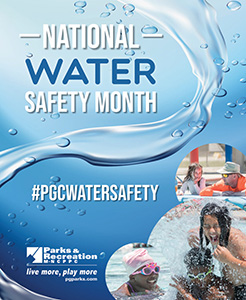
May 15 is International Water Safety Day! If you’re visiting the indoor pools on May 15, please take a moment to sign the pledge and get a sticker!
Cullen Jones – Water Safety Advocate and Olympic Swimmer
Have you heard of #Olympic Gold Medalist @Cullen Jones? When he was 5 years old, Cullen Jones nearly drowned, but that didn’t stop him from getting back in the water! WATCH his amazing story and learn about the importance of swim lessons in this video; https://youtu.be/erg7U8TpmWk
Lifejackets – Safe Boating
Remember to gear up with a properly fitted life jacket or personal floatation device before heading out in the open waters at Bladensburg Waterfront Park or Patuxent River Park!
Get the facts about safe boating here – https://safeboatingcampaign.com/get-the-facts/
FREE TRAINING! – PGParks, Aquatic and Athletic Facilities Division (AAFD)
Keep your water safety knowledge growing with our FREE virtual classes!
Water Safety Training
The Department of Parks and Recreation is an American Red Cross Training Provider. To view class offerings and to register, visit PARKS DIRECT
Water Safety Instructor (WSI) Course
Blended Learning (Ages 16 & Up)
The American Red Cross Water Safety Instructor Blended Learning course trains instructor candidates to teach swim lessons and other water safety programs through instructor lead sessions and interactive online homework assignments.
Requirements
- Must be at least 16 years old
- Participants must have previously passed the Pre-test for Water Safety Instructor Training course that is listed below (both pre-test and course must be taken at the same facility).
- Each homework assignment will require participants to have access to the Internet.
Water Safety Instructor Training Pre-Test (Ages 16 & Up)
This pre-test is necessary for both Water Safety Instructor Training courses (both pre-test and course must be taken at the same facility). Participates must be at least 16 years old and will need to demonstrate the ability to perform the following swimming skill at Youth 4/Adult 4 level proficiency:
- 15 yards Butterfly
- 25 yards Back Crawl
- 25 yards Breaststroke
- 25 yards Elementary Backstroke
- 25 yards Front Crawl
- 25 yards Sidestroke
- Maintain position on back for 1 minute in deep water (floating or sculling)
- Tread water for 1 minute
Water Safety for Parents and Caregivers
The free Water Safety for Parents and Caregivers Online Course focuses on developing an awareness of the risks of drowning and how to minimize those risks, especially for young children. This online course teaches parents and caregivers about the concepts of the circle of drowning prevention, water competency, and the chain of drowning survival. It also provides guidance for applying water safety to common environments and situations where children are most at risk for drowning.
This free program is accessible online in English and Spanish.
Becoming a Water Safety Ambassador
The free Becoming a Water Safety Ambassador course covers fundamentals of water safety, provides an orientation to Red Cross materials to teach water safety in dryland, classroom-based setting, and offers ideas on how to implement water safety education in your community. This online course is intended for teachers as well as adult and youth leaders in the community who are committed to sharing Red Cross resources to impact drowning rates, especially in places that are most at risk for drowning.
This free program is accessible online.
Safety Training for Swim Coaches
The American Red Cross Safety Training for Swim Coaches program, which was developed in partnership with USA Swimming, is designed to teach those involved in competitive swimming including coaches, officials, athletic trainers, and aquatic exercise trainers, how to help:
- Maintain a comfortable and safe environment for swimmers.
- Prevent accidents and emergencies.
- Respond to swimmers with illnesses or injuries in water or on land.
Course Requirements
The Safety Training for Swim Coaches certification requirement can be met through a two-step process:
- All individuals interested in taking Safety Training for Swim Coaches should start by registering for Safety Training for Swim Coaches Online Content Only on redcross.org.
- In Water Verification of Skills:
- Option 1: Coaches who hold a current certification in Lifeguarding, Shallow Water Lifeguarding, or Aquatic Attraction Lifeguarding have satisfied the requirements for Safety Training for Swim Coaches in-water skills and are not required to complete any additional in-water skills sessions.
- Option 2: Coaches who do not hold one of the above certifications can attend an in-water skills session delivered by a Water Safety Instructor or Lifeguarding Instructor. Email pg-aquatics@pgparks.com to connect with a Water Safety or Lifeguarding Instructor.
- Option 3: Print the generic STSC In-Water Skills Checklist and review the skills with an instructor certified by one of the organizations on the USA Swimming checklist. This form can be found on the Red Cross Learning Center.
Course Prerequisites
To participate in the Safety Training for Swim Coaches course, participants must be at least 15 years of age on or before the final scheduled session of the course. There are no skill prerequisites to enroll in the Safety Training for Swim Coaches course. However, because there is an in-water skills session, participants must be comfortable in chest-deep water.
Certification Requirements
To receive the course completion certificate, the participant must:
- Complete the online portion of the course, including achieving a minimum score of 80 percent on the online written exam.
- Meet the in-water skill verification requirement by either
- Completing the in-water skill session
- Maintaining a lifeguarding certification
- Having skills reviewed by an instructor certified by one of the organizations on the USA Swimming checklist
Upon successful completion of the Safety Training for Swim Coaches online content and meeting the in-water skill verification requirement, participants should provide the necessary certificates and documentation as proof of course completion to their national governing body, such as USA Swimming and Y-USA.
Pool Employment
M-NCPPC, Department of Parks and Recreation, Prince George’s County has immediate openings for Lifeguards.
Looking for a fun and exciting job? Consider a position with the Prince George’s County Department of Parks and Recreation Aquatics team.
Get Certified
M-NCPPC offers FREE* Lifeguard Training to prospective employees. Sign up for a Lifeguard Pre-Test today for only $10. M-NCPPC even offers Lifeguard Prep Swim Lessons for those who need to improve their swimming skills to help pass the Lifeguarding Pre-Test.
*If a participant takes a Department Lifeguarding class, does not pass, does not apply, and/or get hired by M-NCPPC, they will have to pay the course fees.
Apply
Applicants must be 15 years of age to work for M-NCPPC. All you need to get started is a great work attitude and a completed Aquatics Employment Application. Search online for the positions listed below for which you are qualified. Please note that not all positions are advertised year-round.
Positions
- Assistant Pool Manager (Must be at least 18 years of age) – Earn up to $23.15 per hour
- Lifeguard – Earn up to $20.26 per hour
- Pool Manager (Must be at least 21 years of age) – Earn up to $25.47 per hour
- Shallow Water Lifeguard (Glenn Dale Splash Park/summer only) – Earn up to $18.75 per hour
- Swim Coach – Earn up to $26.00 per hour
- Swim Lesson Aide – Earn up to $21.42 per hour
- Swim Lesson Instructor – Earn up to $25.47 per hour
- Water Fitness Instructor (salary will depend on certification and experience)
Benefits
M-NCPPC offers great benefits including:
- Flexible schedules
- Free uniforms
- On-site supervisors
- Paid training
- Year-round jobs and promotions
Certified Pool Operator Training
The Pool & Hot Tub Alliance® Certified Pool & Spa Operator (CPO) Certification program provides individuals with the basic knowledge, techniques, and skills of pool and spa operations. Participants must be 16 years of age in order to participate in this course, attend all course sessions and pass the final exam to be issued a CPO Certification. To view class offerings and to register, visit PARKS DIRECT.
Blended Learning Format
Part 1: Pool Operator Primer Prerequisite
- This is the first step to earning the CPO Certification, and prerequisite for the Pool Operator Fusion training, using the blended format training course.
- The online curriculum consists of 8 lessons that cover all 18 chapters in the included Pool & Spa Operator Handbook.
- The online Pool Operator Primer takes between 8-14 hours to complete.
Part 2: Pool Operator Fusion
- Once you have completed the Pool Operator Primer, you will attend an 8-hour (two, 4 hour) Virtual Classroom Sessions led by a PHTA Certified Pool & Spa Operator Instructor online in Microsoft Teams.
- Minimum 37 points (74%) on the CPO certification online exam.
Additional Information
Candidates must be visible on webcam the entire time while taking the exam. Phones are not recommended for taking the exam because the small screen size may make it difficult to read the text questions. If necessary, the candidate may use one device for providing webcam capability (phone, tablet) while using another device to take the exam. Candidates will need to show or send the Instructor a photo identification at the beginning of the virtual classroom session. To view class offerings and to register, visit PARKS DIRECT. Please call 301-446-6896 or click here to email us if you have questions.
Lifeguard Training
FREE Lifeguard Training is available for candidates who successfully complete/meet the following pre-employment requirements:
- Candidates must be at least 15 years of age to work for the Department.
- Complete an online application via this job posting. Apply for a Lifeguard position.
- Candidates can interview with a Facility Manager at one of the hiring facilities listed above.
- Complete the required American Red Cross Precourse Skills assessment which includes successfully demonstrating the below skills:
- Jump into the water from the side, totally submerge, recover to the surface and swim 150 yards.
- After swimming 150 yards, maintain position at the surface of the water without support for 2 minutes by treading.
- After maintaining position at the surface of the water for 2 minutes, swim 50 more yards.
- Starting in the water, swim 20 yards then surface dive, feet-first or head-first, to a depth of 7-10 feet to retrieve a 10-pound object.
- Surface and swim 20 yards on back, with both hands holding the object.
- Exit the water without using a ladder or steps.
- Commit to working for the Department of Parks and Recreation at one of the hiring facilities listed above.
Once candidates complete/meet the pre-employment requirements, they will be assigned to an American Red Cross Lifeguarding course offered at one of our department aquatic facilities within 1-2 weeks of the interview.
The Department of Parks and Recreation is an American Red Cross Training Provider. To view class offerings and to register, visit the PARKS DIRECT.
Lifeguard Prep Swim Lessons (Ages 15 & Up)
Interested in taking the Lifeguarding Training course, but need more practice? Register for these swim prep swim lessons that focus on stroke development and endurance and help prepare swimmers for the Lifeguard Pre-Test. To view class offerings and to register, visit the PARKS DIRECT.
Requirements
- Participants must be comfortable in deep water and be able to swim at least 100 yards continuously using front crawl and/or breaststroke.
- Participants in the course must have an application on file with Facility Director prior to taking this course.
- Participants must also commit to working for an M-NCPPC pool for the upcoming pool season.
- Must be at least 15 years old.
Lifeguard Training (Ages 15 & Up)
The purpose of the American Red Cross Lifeguarding course is to provide entry-level lifeguard participants with the knowledge and skills to prevent, recognize, and respond to aquatic emergencies and to provide care for breathing and cardiac emergencies, injuries, and sudden illnesses until Emergency Medical Services (EMS) personnel take over. This course is offered as a blended learning course with interactive eLearning modules and instructor-led sessions. Register for the Lifeguard Pre-Test first, once you pass the pre-test then you would register for the Lifeguard Training course. To view class offerings and to register, visit the PARKS DIRECT.
Requirements
- Must be at least 15 years old
- Participants must have previously passed the Lifeguard Pre-test that is listed below (both pre-test and course must be taken at the same facility).
Lifeguard Pre-Test (Ages 15 & Up)
This pre-test is necessary for the Lifeguard Training course (both pre-test and course must be taken at the same facility). Register for the pre-test prior to registering for Lifeguard Training, to view class offerings and to register, visit the PARKS DIRECT.
Participants must be at least 15 years old and demonstrate the following:
- Jump into the water from the side, totally submerge, recover to the surface and swim 150 yards.
- After maintaining position at the surface of the water for 2 minutes, swim 50 more yards.
- Complete a timed event within 1 minute, 40 seconds
- Starting in the water, swim 20 yards then surface dive, feet-first or head-first, to a depth of 7 to 10 feet to retrieve a 10-pound object.
- Surface and swim 20 yards on back, with both hands holding the object.
- Exit the water without using a ladder or steps.
Lifeguard Instructor Training (Ages 17 & Up)
Become certified as an American Red Cross Lifeguarding Instructor. This course teaches students to train and certify participants in Lifeguarding and CPR/AED. Participants must be currently certified in basic-level Lifeguarding/First Aid/CPR/AED.
Course Completion Requirements
- Successfully complete the Online Session prior to the Pre-course session
- Successfully complete the Pre-course session
- Attend and actively participate in all course sessions
- Successfully complete class activities, including the required practice-teaching assignments. Pass the Bloodborne Pathogens Training Instructor Self-Study Test
- Pass the basic-level Administering Emergency Oxygen final written exam
- Pass the Lifeguarding Instructor course final written exam
Swimming Skills Evaluation
During the Pre-course Session, you must successfully demonstrate competency in the following swimming skills evaluation and four rescue skill scenarios:
- Jump into the water from the side, totally submerge, recover to the surface and swim 150 yards.
- After swimming 150 yards, maintain position at the surface of the water without support for 2 minutes by treading.
- After maintaining position at the surface of the water for 2 minutes, swim 50 more yards.
- Must complete a timed event within 1 minute and 40 seconds
- Starting in the water, swim 20 yards then surface dive, feet-first or head-first, to a depth of 7 to 10 feet to retrieve a 10-pound object.
- Surface and swim 20 yards on back, with both hands holding the object.
- Exit the water without using a ladder or steps.
- Primary Assessment and Infant CPR Scenario
- Suspected head injury rescue
- Active victim rescue scenario
- Submerged victim in 7 to 10 feet of water and perform one-rescuer adult CPR scenario for 3 minutes.
Pre-test and training courses must be taken at the same facility.
Shallow Water Lifeguard Training (Ages 15 & Up)
Become an American Red Cross Shallow Water Lifeguard. The primary purpose of this course is to learn the knowledge and skills needed to prevent and respond to aquatic emergencies in shallow water up to 5 feet deep. Participants must have previously passed the Shallow Water Lifeguard Pre-test (both pre-test and course must be taken at the same facility). This course is for those who are interested in working at M-NCPPC’s Glenn Dale Splash Park during the summer season only.
Shallow Water Lifeguard Pre-Test
Pre-test for Water Attendant training course-both courses must be taken at the same facility. Participants must show proof of age and demonstrate the following:
- Swim continuously for 100 yards using the front crawl, breaststroke, or a combination of both.
- Tread water for 2 minutes using only the legs (hand placed across chest under armpits)
- Must complete a timed event within 50 seconds
- Starting in the water, swim 20 yards using front crawl or breaststroke then submerge to a depth of 4 to 5 feet to retrieve a 10-pound object.
- Return to the surface and walk or swim 20 yards to the starting point with both hands holding the object at the surface of the water.
- Exit the pool without using a ladder or steps.
Water Safety
Welcome to Water Safety!
This month M-NCPPC, Department of Parks and Recreation, Prince George’s County is helping bring water awareness and swim safety to the community. This webpage contains tips, links, and best practices to keep you and your family safe in, on, and around the water.
Jerald Harkness – Water Safety Advocate and Filmmaker
“When Everyone Swims” is a feature-length documentary that addresses the public health issue of drowning and the history of racial disparities with swimming as well as celebrates some inspirational swim journeys of people who overcame obstacles to have a positive relationship with the water. View the trailer here.
Saturday Morning Cartoons – American Red Cross
Water Safety – American Red Cross
Do you know how to swim? Many people say yes to this but aren’t sure what it really means.
Watch experts discuss Water Competency skills in this 75-second video and then take this quiz to see if you can do the basic skills needed to be Water Competent.
How To Prepare For Emergencies
Looking for more safety topics or lessons for kids? Visit https://www.redcross.org/watersafety
If you’re ready to learn or improve be sure to check out Parks Direct for our summer offerings.
Centennial Campaign – American Red Cross
Have you seen our Centennial Campaign banners at our pools? The Department of Parks and Recreation, Prince George’s County is honored to be a partner and grant recipient of the American Red Cross’s Centennial Campaign. Check out this video that features some of our amazing staff and highlights the goal of this campaign.
Pool Safely – Consumer Product Safety Commission
Is your child like a fish in the water? Be sure to watch this public service announcement (PSA) to help you prepare for a safe swimming season.
What if Kids Had Gills and Fins PSA | English Link
¿Y si los niños se convirtieran en peces? | Spanish Link
Take the pledge here or at our indoor pools on May 15!
International Water Safety Day – International Water Safety Foundation

May 15 is International Water Safety Day! If you’re visiting the indoor pools on May 15, please take a moment to sign the pledge and get a sticker!
Cullen Jones – Water Safety Advocate and Olympic Swimmer
Have you heard of #Olympic Gold Medalist Cullen Jones? When he was five years old, Cullen Jones nearly drowned, but that didn’t stop him from getting back in the water! Watch his amazing story and learn about the importance of swim lessons in this video.
Lifejackets – Safe Boating
Remember to gear up with a properly fitted life jacket or personal floatation device before heading out in the open waters at Bladensburg Waterfront Park or Patuxent River Park!
Get the facts about safe boating here.
FREE TRAINING! – PGParks, Aquatic and Athletic Facilities Division (AAFD)
Keep your water safety knowledge growing with our FREE virtual classes!
Water Safety Training
The Department of Parks and Recreation is an American Red Cross Training Provider. To view class offerings and to register, visit PARKS DIRECT
Water Safety Instructor (WSI) Course
Blended Learning (Ages 16 & Up)
The American Red Cross Water Safety Instructor Blended Learning course trains instructor candidates to teach swim lessons and other water safety programs through instructor lead sessions and interactive online homework assignments.
Requirements
- Must be at least 16 years old
- Participants must have previously passed the Pre-test for Water Safety Instructor Training course that is listed below (both pre-test and course must be taken at the same facility).
- Each homework assignment will require participants to have access to the Internet.
Water Safety Instructor Training Pre-Test (Ages 16 & Up)
This pre-test is necessary for both Water Safety Instructor Training courses (both pre-test and course must be taken at the same facility). Participants must be at least 16 years old and will need to demonstrate the ability to perform the following swimming skill at Youth 4/Adult 4 level proficiency:
- 15 yards Butterfly
- 25 yards Back Crawl
- 25 yards Breaststroke
- 25 yards Elementary Backstroke
- 25 yards Front Crawl
- 25 yards Sidestroke
- Maintain position on back for one minute in deep water (floating or sculling)
- Tread water for one minute
Water Safety for Parents and Caregivers
The free Water Safety for Parents and Caregivers Online Course focuses on developing an awareness of the risks of drowning and how to minimize those risks, especially for young children. This online course teaches parents and caregivers about the concepts of the circle of drowning prevention, water competency, and the chain of drowning survival. It also provides guidance for applying water safety to common environments and situations where children are most at risk for drowning.
This free program is accessible online in English and Spanish.
Becoming a Water Safety Ambassador
The free Becoming a Water Safety Ambassador course covers fundamentals of water safety, provides an orientation to Red Cross materials to teach water safety in dryland, classroom-based setting, and offers ideas on how to implement water safety education in your community. This online course is intended for teachers as well as adult and youth leaders in the community who are committed to sharing Red Cross resources to impact drowning rates, especially in places that are most at risk for drowning.
This free program is accessible online.
Safety Training for Swim Coaches
The American Red Cross Safety Training for Swim Coaches program, which was developed in partnership with USA Swimming, is designed to teach those involved in competitive swimming including coaches, officials, athletic trainers, and aquatic exercise trainers, how to help:
- Maintain a comfortable and safe environment for swimmers.
- Prevent accidents and emergencies.
- Respond to swimmers with illnesses or injuries in water or on land.
Course Requirements
The Safety Training for Swim Coaches certification requirement can be met through a two-step process:
- All individuals interested in taking Safety Training for Swim Coaches should start by registering for Safety Training for Swim Coaches Online Content Only on redcross.org.
- In Water Verification of Skills:
- Option 1: Coaches who hold a current certification in Lifeguarding, Shallow Water Lifeguarding, or Aquatic Attraction Lifeguarding have satisfied the requirements for Safety Training for Swim Coaches in-water skills and are not required to complete any additional in-water skills sessions.
- Option 2: Coaches who do not hold one of the above certifications can attend an in-water skills session delivered by a Water Safety Instructor or Lifeguarding Instructor. Email pg-aquatics@pgparks.com to connect with a Water Safety or Lifeguarding Instructor.
- Option 3: Print the generic STSC In-Water Skills Checklist and review the skills with an instructor certified by one of the organizations on the USA Swimming checklist. This form can be found on the Red Cross Learning Center.
Course Prerequisites
To participate in the Safety Training for Swim Coaches course, participants must be at least 15 years of age on or before the final scheduled session of the course. There are no skill prerequisites to enroll in the Safety Training for Swim Coaches course. However, because there is an in-water skills session, participants must be comfortable in chest-deep water.
Certification Requirements
To receive the course completion certificate, the participant must:
- Complete the online portion of the course, including achieving a minimum score of 80 percent on the online written exam.
- Meet the in-water skill verification requirement by either
- Completing the in-water skill session
- Maintaining a lifeguarding certification
- Having skills reviewed by an instructor certified by one of the organizations on the USA Swimming checklist
Upon successful completion of the Safety Training for Swim Coaches online content and meeting the in-water skill verification requirement, participants should provide the necessary certificates and documentation as proof of course completion to their national governing body, such as USA Swimming and Y-USA.
Pool Employment
M-NCPPC, Department of Parks and Recreation, Prince George’s County has immediate openings for Lifeguards.
Looking for a fun and exciting job? Consider a position with the Prince George’s County Department of Parks and Recreation Aquatics team.
Get Certified
M-NCPPC offers FREE* Lifeguard Training to prospective employees. Sign up for a Lifeguard Pre-Test today for only $10. M-NCPPC even offers Lifeguard Prep Swim Lessons for those who need to improve their swimming skills to help pass the Lifeguarding Pre-Test.
*If a participant takes a Department Lifeguarding class, does not pass, does not apply, and/or get hired by M-NCPPC, they will have to pay the course fees.
Apply
Applicants must be 15 years of age to work for M-NCPPC. All you need to get started is a great work attitude and a completed Aquatics Employment Application. Search online for the positions listed below for which you are qualified. Please note that not all positions are advertised year-round.
Positions
- Ramp Guard/Slide Attendant – $18.52
- Assistant Pool Manager (Must be at least 18 years of age) – Earn up to $24.31 per hour
- Lifeguard – Earn up to $21.42 per hour
- Pool Manager (Must be at least 21 years of age) – Earn up to $26.63 per hour
- Shallow Water Lifeguard (Glenn Dale Splash Park/summer only) – Earn up to $19.91 per hour
- Swim Coach – Earn up to $26 per hour
- Swim Lesson Aide – Earn up to $22.57 per hour
- Swim Lesson Instructor – Earn up to $26.63 per hour
- Water Fitness Instructor (salary will depend on certification and experience)
Benefits
M-NCPPC offers great benefits including:
- Flexible schedules
- Free uniforms
- On-site supervisors
- Paid training
- Year-round jobs and promotions
